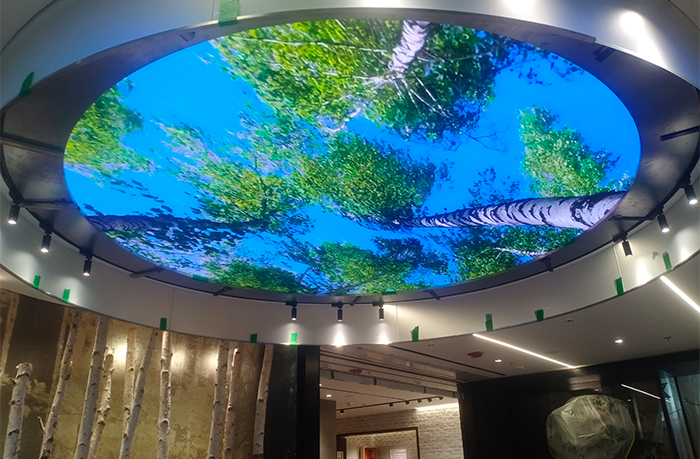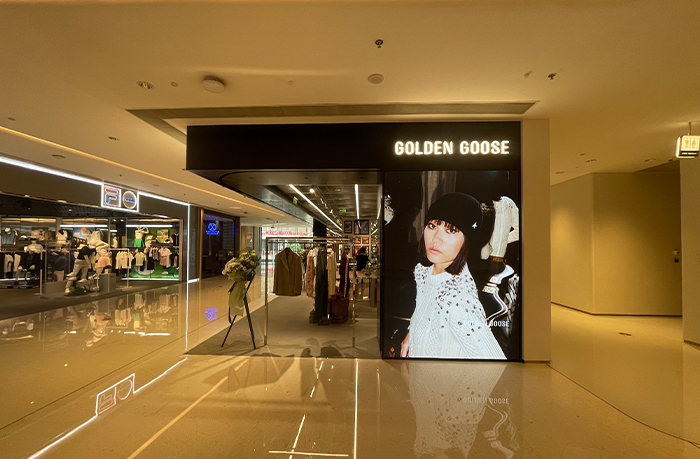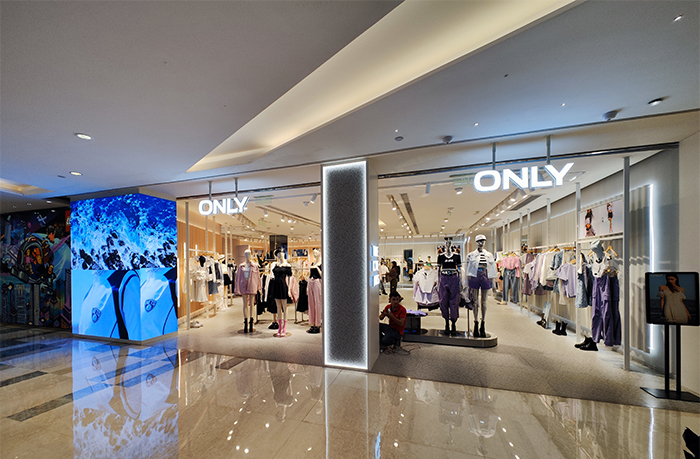In recent years, a noticeable shift has occurred in retail marketing strategies, with stores increasingly replacing traditional posters and signage with advanced LED displays. What’s particularly striking is the growing preference for LED screens featuring extremely small pixel pitches. This trend reflects the convergence of technological advancements, changing consumer expectations, and evolving marketing needs in the retail landscape.

The primary driver behind this shift is the superior visual performance offered by small-pixel-pitch LED displays. Pixel pitch refers to the distance between adjacent pixels, measured in millimeters, and smaller values indicate higher pixel density. Modern retail environments commonly utilize displays with pixel pitches ranging from 1.2mm to 4mm, with luxury retail spaces often opting for ultra-fine pitches between 1.2mm and 2.5mm. This technological choice directly addresses the unique viewing conditions in retail settings where customers typically engage with displays at close distances—often less than 5 meters. The high pixel density of these screens delivers exceptional clarity, with some models boasting pixel densities from 69,444 pixels per square meter (for 1.2mm pitch) down to 6,250 pixels per square meter (for 4mm pitch), ensuring sharp, seamless visuals even at close range.

Beyond resolution, these advanced displays offer other critical visual advantages. With brightness levels around 800 cd/㎡ and auto-adjustment capabilities, they maintain optimal visibility without causing glare in indoor environments. Combined with wide viewing angles of at least 160 degrees and precise color reproduction (ΔE < 1.5), these displays ensure consistent image quality from virtually any position in the store. This technical performance translates directly to more engaging customer experiences, as vibrant, high-definition visuals capture attention more effectively than traditional static signage.

The effectiveness of small-pixel-pitch LED displays in driving consumer action has been validated by market research. A recent survey revealed that 95% of consumers feel either positive or neutral toward in-store digital media, with only 4% reporting that such ads detract from their shopping experience. Most importantly, nearly half (44%) of shoppers surveyed indicated they made a purchase because of an in-store digital ad. The impact is even more pronounced with strategic placement—58% of shoppers who viewed entrance displays bought the advertised product immediately, while 31% of those who saw in-aisle displays redeemed a coupon or discount code. These statistics demonstrate how high-quality digital displays create meaningful connections with customers at critical decision points.

While the initial investment in small-pixel-pitch LED technology remains significant, the long-term cost-effectiveness has improved dramatically. In 2025, LED video walls cost between \(380 and \)1,200 per square foot, with prices varying by pixel pitch. However, technological advancements have narrowed the price gap between different pitches—for example, 2.5mm pitch displays cost only 8% more than 3.9mm pitch models. When considering total cost of ownership, LED displays offer substantial savings through energy efficiency, consuming 50-75% less energy than traditional fluorescent signs. A 6m x 4m LED advertising screen typically consumes 600W, compared to 1,500W for an equivalent conventional screen. With lifespans exceeding 50,000 hours—five times longer than traditional fluorescent tubes—LED displays significantly reduce replacement and maintenance costs over time.

Technological innovations have further enhanced the appeal of these displays for retail applications. Chip-on-Board (COB) technology, which directly bonds LED chips to circuit boards, reduces pixel failure rates by 80% while improving durability and resistance to dust and physical impacts—critical advantages in high-traffic retail environments. Modular designs support flexible installation, including 90° folding capabilities that reduce transport volume by 40%, while front-maintenance features allow for quick repairs within 5 minutes. These technical improvements have made small-pixel-pitch LEDs more practical and reliable for continuous 24/7 operation in various retail settings.

The rapid growth of the LED display market reflects its increasing importance in retail strategies. The global LED display market reached \(8.63 billion in 2025 and is projected to grow to \)12.45 billion by 2033, with a compound annual growth rate (CAGR) of 4.7%. Specifically, the fine pixel pitch LED segment is expanding even faster at a 5.8% CAGR, from \(3.10 billion in 2023 to an expected \)5.15 billion by 2032. This growth is driven by retailers’ recognition that high-quality digital displays enhance brand image, provide flexible content management, and create immersive shopping experiences that drive customer engagement and sales. As consumer expectations for digital experiences continue to rise, small-pixel-pitch LED displays have become essential tools for retailers seeking to stay competitive in an increasingly digital marketplace.

In conclusion, the widespread adoption of small-pixel-pitch LED displays in retail advertising stems from their superior visual performance, proven effectiveness in driving consumer action, improving cost-effectiveness, and ongoing technological advancements. These displays represent more than just a marketing upgrade—they are a strategic investment that helps retailers create more engaging, dynamic, and personalized shopping experiences. As technology continues to evolve and costs decline further, we can expect even broader implementation of small-pixel-pitch LED displays across the retail landscape.




 DECENT Technology is a leading global supplier of LED display screens, providing customers worldwide with comprehensive solutions for the research and development, manufacturing, engineering installation, and after-sales service of high-end LED display equipment and display control systems. At present, it has developed into a national high-tech enterprise with over 1300 employees and more than 400 authorized national patents. The company has successively obtained safety production license, steel structure construction qualification, system integration qualification, third level professional contracting for building mechanical and electrical installation engineering, and second level professional contracting for electronic and intelligent engineering.
DECENT Technology is positioned as "core technology oriented" and has deeply cultivated and worked in the LED industry. It has established numerous marketing centers, offices, and after-sales service outlets worldwide. The company's products are distributed in more than 200 countries and regions, and has accumulated over 40000 classic cases. The strong comprehensive strength has made DECENT Technology the preferred brand among the Fortune Global 500 companies such as Sinopec, PetroChina, Tencent, Alibaba, Huawei, and Abbott.
Since its establishment, DECENT Technology has accumulated 10 industry-leading technologies and 43 innovative "black technology" technologies; And we have developed six product lines, including professional display, universal display, conference display, commercial display, outdoor led display, and rental display, which are applied in multiple scenarios such as command and monitoring, commercial display retail, broadcasting and broadcasting, outdoor advertising, sports events, and stage performances. The product quality maintains a leading position in the industry.
In the future, DECENT Technology will continue to adhere to the business philosophy of "product+service" and the corporate values of "innovation, sunshine, struggle, and gratitude", continuously moving towards higher technology, better services, and harder quality, committed to providing professional LED display system solutions for every customer.
DECENT Technology is a leading global supplier of LED display screens, providing customers worldwide with comprehensive solutions for the research and development, manufacturing, engineering installation, and after-sales service of high-end LED display equipment and display control systems. At present, it has developed into a national high-tech enterprise with over 1300 employees and more than 400 authorized national patents. The company has successively obtained safety production license, steel structure construction qualification, system integration qualification, third level professional contracting for building mechanical and electrical installation engineering, and second level professional contracting for electronic and intelligent engineering.
DECENT Technology is positioned as "core technology oriented" and has deeply cultivated and worked in the LED industry. It has established numerous marketing centers, offices, and after-sales service outlets worldwide. The company's products are distributed in more than 200 countries and regions, and has accumulated over 40000 classic cases. The strong comprehensive strength has made DECENT Technology the preferred brand among the Fortune Global 500 companies such as Sinopec, PetroChina, Tencent, Alibaba, Huawei, and Abbott.
Since its establishment, DECENT Technology has accumulated 10 industry-leading technologies and 43 innovative "black technology" technologies; And we have developed six product lines, including professional display, universal display, conference display, commercial display, outdoor led display, and rental display, which are applied in multiple scenarios such as command and monitoring, commercial display retail, broadcasting and broadcasting, outdoor advertising, sports events, and stage performances. The product quality maintains a leading position in the industry.
In the future, DECENT Technology will continue to adhere to the business philosophy of "product+service" and the corporate values of "innovation, sunshine, struggle, and gratitude", continuously moving towards higher technology, better services, and harder quality, committed to providing professional LED display system solutions for every customer.